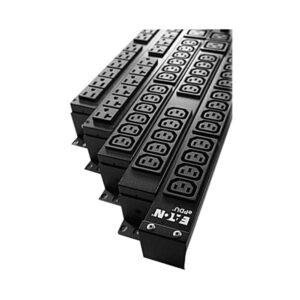Power distribution is the means by which AC power facilitated through different pieces of equipment that take the power conditioned by your uninterruptible power supply (UPS) and send it to your IT equipment. Power distribution solutions can manage and even control energy consumption in smaller environments as well as large data center applications. Distributing power efficiently results in reduced operating costs and increased reliability.
uninterruptible power supply (UPS) and send it to your IT equipment. Power distribution solutions can manage and even control energy consumption in smaller environments as well as large data center applications. Distributing power efficiently results in reduced operating costs and increased reliability.
Rack power distribution units, also known as rack PDUs, are a key component to any IT environment. They do exactly as the name suggests and distribute power to network equipment within racks. A common misconception is that they’re just power strips, and at first glance, they even look like it, but modern rack PDUs provide benefits a simple power strip cannot. Some of the valuable features include network connectivity, environmental monitoring and remote access, but we’ll get more into that later. This guide should help you get familiar with power distribution, gain interesting insights and learn some key considerations for future IT investments.
There are two major types of PDUs, rack based or floor based and there are several considerations to take into account when making your choice.
Questions to consider when choosing a PDU
It is important to review these questions, so you are prepared for the type of decisions you may need to make when evaluating a PDU.
1.- What input plug and output receptacles do you need?
2.- How many different outlets do you need?
3.- What kW power range will you require?
a. 0-5 kW – Standard density
b. 5-10 kW – High density
c. 10+ – Ultra high density
4.- Where will you be installing the PDU? If applicable, what size rack will you be installing the PDU and will it be horizontally or vertically mounted?
a. OU (Vertically mounted)
b. 1U (Horizontally mounted)
c. 1U and 2U (Horizontally mounted)
5.- What functionality do you need?
a. Basic – distribute power among your equipment
b. Metered input – includes a LCD display, easy serviceability and advanced measurement capabilities
c. Metered outlet – allows you to monitor at the outlet level
d. Managed – includes remote monitoring and management capabilities to the outlet level
e. Hotswap — enhances availability by facilitating UPS replacement without shutting down connected equipment
f. Remote emergency power off – immediate and complete power off control from one button
g. Automatic transfer switch — Transfers power from primary to secondary source for power redundancy to equipment with a single power supply.
Contact ECS today, and we will provide the best and most suitable solution with Power Distribution Units.

